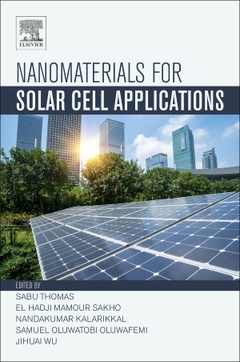Description
Nanomaterials for Solar Cell Applications
Coordinators: Thomas Sabu, Mamour Sakho El Hadji, Kalarikkal Nandakumar, Samuel Oluwafemi Oluwatobi, Wu Jihuai
Language: English
Subject for Nanomaterials for Solar Cell Applications:
760 p. · 15x22.8 cm · Paperback
Description
/li>Contents
/li>Readership
/li>Biography
/li>Comment
/li>
Nanomaterials for Solar Cell Applications provides a review of recent developments in the field of nanomaterials based solar cells. It begins with a discussion of the fundamentals of nanomaterials for solar calls, including a discussion of lifecycle assessments and characterization techniques. Next, it reviews various types of solar cells, i.e., Thin film, Metal-oxide, Nanowire, Nanorod and Nanoporous materials, and more. Other topics covered include a review of quantum dot sensitized and perovskite and polymer nanocomposites-based solar cells. This book is an ideal resource for those working in this evolving field of nanomaterials and renewable energy.
Part I Fundamental of Nanomaterials for Solar Cells 1
1. Fundamentals of solar cells
2. Life-cycle assessment of photovoltaic systems
3. Introduction to nanomaterials: synthesis and applications
4. Characterization techniques for nanomaterials
Part II Metal oxide-based solar cells
5. TiO2-based dye-sensitized solar cells
6. ZnO-based dye-sensitized solar cells
7. SnO2 dye-sensitized solar cells
8. Nb2O5 dye-sensitized solar cells
Part III Nanowire, nanorod and nanoporous materials-based solar
9. Silicon nanowire-based solar cells
Part IV Others
10. Nanorod-based dye sensitized solar cells
11. Quantum dots for solar cell applications
12. Perovskite solar cells
13. Metal nanostructures for solar cells
14. Electrolyte for dye-sensitized, quantum dots, and perovskite solar cells
15. Polymer nanocomposites for solar cells: research trends and perspectives
Part V Nano-carbon materials-based solar cells
16. Graphene and carbon nanotube-based solar cells
17. Fullerene-based solar cells
18. Metal-assisted chemical etching based nanostructured
Index
Academics, researchers, Ph.D. students master’s students, industrialists and scientists (primarily in the field of material science, applied chemistry and applied physics). Professionals, researchers, industrial practitioners, graduate students, and senior undergraduates in the fields of physics, chemistry, materials science and nanoscience and nanotechnology, who work in similar areas or are interested in the field solar cells
Dr. Thomas is the Vice-Chancellor and a Professor of Polymer Science and Engineering at Mahatma Gandhi University, India. Additionally, he serves as the Director of the School of Energy Materials at the same institution. Dr. Thomas is internationally recognized for his contributions to polymer science and engineering, covering polymer nanocomposites, elastomers, polymer blends, interpenetrating polymer networks, polymer membranes, green composites, nanocomposites, nanomedicine, and green nanotechnology. His groundbreaking inventions in polymer nanocomposites, polymer blends, green bionanotechnological, and nano-biomedical sciences have significantly contributed to the development of new materials in the automotive, space, housing, and biomedical fields. Dr. Thomas has been conferred with Honoris Causa (DSc) by the University of South Brittany, Lorient, France.
Dr. El Hadji Mamour Sakho received his PhD degree in Applied Physics from Mahatma Gandhi University, India in 2016. Currently he is a postdoctoral fellow in the Department of Applied Chemistry, University of Johannesburg, South Africa under the supervision of Prof. SO Oluwafemi His research focus is on the synthesis and characterization of graphene based hybrid materials for different applications such as solar cells, batteries, nonlinear optical applications, sensors, photocatalysts and polymer nanocomposites.
Dr. Nandakumar Kalarikkal is an Associate Professor at the School of Pure and Applied Physics and Joint Director of the International and Inter University Centre for Nanoscience and Nanotechnology of Mahatma Gandhi University, Kottayam, Kerala, India. His research activities involve applications of nanostructured materials, laser plasma, and phase transitions. He is the recipient of research fellowships and associateships from prestigious government organizations such as the Department of Science and Technology and Council of Scientific and Industrial Research of the Government of India. H
- Provides a well-organized approach to the use of nanomaterials for solar cell applications
- Discusses the synthesis, characterization and applications of traditional and new material
- Includes coverage of emerging nanomaterials, such as graphene, graphene-derivatives and perovskites

